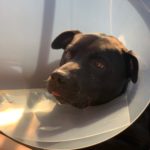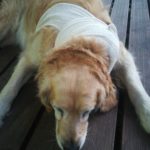Trying to get info from a photo is very difficult. If it were me, I would make an appointment for the vet and ask them to do a biopsy. It could just be a small injury, but it could be worse too. I hope it is nothing- best of luck!!!
.
I have a 14 month old pit mix that has terrible anxiety. He is terrified of being by himself, even if we are just behind the closed door using the bathroom. He cries terribly & will pace the house until we’re done. If I take a shower or bath I leave the door open so he feels a little better, but he then cries & tries to grab my arm to pull me out (not in an aggressive way). When people come into the house he paces, jumps, & whines for them. He also does this outside when he sees people or other dogs. He is told “down” when he jumps & warned with the beeping noise on his training collar. He will sit but it is very hard for him to stay still, as he continues to whine, shakes, & then rolls into the ground. It’s like he knows to listen & tries very hard but literally can not stay still. He also is terrified of thunder & the sound the trash truck makes. When those sounds are occurring he runs right under the table & won’t come out. We are in the process of training & we were told by them that they also think he has anxiety. They think he would be able to comprehend better if it was under control. I have been researching non stop for things to help with this major issue. I don’t want him on prescription anxiety meds that cause him to seem “sedated” & not like himself (that happened with my family dog). I have come across a tablet to help with separation anxiety & the behaviors that come with it. It is called clomicalm & every review or story I have read about it was positive. I really do think this could be a successful choice for him IF I know this is something that is not harmful. There are possible side effects that could occur but that could happen with pretty much any medication humans or pets. This tablet does not cause dogs to seem drowsy from what I’ve read from people’s experiences & has a high success rate to treat anxiety. We have tried natural treats, oils, thunder vests, etc. & nothing has helped him in the slightest bit. I just want to know if this something that would be okay for him to take daily or even okay to take at all?
Comments
My 18 month old pit mix woke up with this nodule type bump on her face. It was hard and crusty and now it’s open. I dint think it’s painful but she doesn’t like me to mess with it. I got the best pic I could. No other symptoms at all.
Comments
Our 15lb Chihuahua/Maltese mix has a gurgling belly. You can hear the noise just being in the same room as him. He is super uncomfortable, sits down for a moment- you hear a gurgle and he shoots back up and circles then sits down again. It happens about once a month and lasts for about 12-24hrs. We have taken him into our vet a few times for it but by the time we take him in it has subsided. I believe they typically give him a one time dose of an antiemetic. Most of the time we have him leashed & am outside with him so we do not believe he is eating something. No table food, eats science diet. Has regular, formed, bowel movements. Unsure of what to do or how to make him feel better! We can not afford to keep taking him to the vet & not have answers of why this keeps happening.
Comments
Our 4 year old Chow/Australian Shepard mix male dog has been scooting to the point he has lost hair on his hind legs /bottom – resembling a baboon. The skin is normal and not inflamed. We had his anal glands expressed, added pumpkin to his diet and had him checked a few weeks ago and his glands were ok. He has started scooting again. We were told he may have allergies and have put him on 1 diphenhydramine 25 mg daily. He stopped scooting for a few weeks, but is back at it again. Advice and suggestions are appreciated. Thank you.
Comments
Pit bull mix with suspected ivdd. Losing the mobility in his hind legs. Urinating and defecating on himself and the only option I was give was a 10,000$ surgery. I just need advice on how to care for my poor dog so that he can have a quality life. I got him when he was 8 weeks old and I was only 16 so we have grown up together I love him to pieces. Please help me!
Comments
I have the sweetest Siamese mix, Goldie, adopted from our local humane society. Unfortunately, she has been a sick kitty and she’s had 4 URIs in her two years of life. She did take the full course of antibiotics for all of them and healed successfully.
Recently, she’s been making low snoring noises periodically when awake and sleeping and it seems to be only when inhaling. She’s a talkative girl and sometimes her voice changes when meowing. She has no other symptoms and is eating, drinking and playing normally and there has been no mouth breathing while making the noises. Her breathing rate has been normal. Sometimes it seems like she is making the noises and then stretches out real long in the first picture to get comfortable.
Below is a link to her video around 24 seconds you can hear it, you might have to put it at full volume:
If this is difficult to hear it sounds very similar to this:
I have a vet appointment next week and am concerned she has stertor from an oropharyngeal polyp from my online research and her symptoms. Is this something that a vet would be able to see without putting them under sedation? Are there any other suggestions you have as to what I could have them test for if it’s not a polyp? I wasn’t sure if she could have asthma or another breathing related issue.
Finally, do you by chance have any recommendations for vets in Phoenix, Arizona? I am just getting myself prepared if needed for a second opinion or if surgery is necessary.
Appreciate it and all your tips and videos online! You are doing incredible work!
Comments
Our 2 year old Pitt mix recently suffered from a laceration to his front paw pad. We ended up bringing him into the ER for stitches, which he received. However, neither the vets or ourselves were able to get him in his cone of shame. For about 4 days we were able to deter him from interfering with his wound through careful monitoring and a sock with cayenne pepper placed over the bandage. Day # 5, however, is when things went to pieces. Sometime between lunch and when I get off work, he was able to get his bandage off and proceeded to gnaw at his stitches… We took him back to the ER last night, but given how he is with strangers (not good), we opted to forgo getting him sedated and re-stitched, and try to take care of him from home. He lets us change his bandage, but when I tried changing it this morning, some of the gauze had adhered to the wound. I’m afraid if I pull more of it off, I will make the wound worse, but I can’t imagine that leaving it on there is a good idea either. If we can avoid even more costly medical bills without jeopardizing his health, that would be great. That being said, I’m reaching out to the canine community for any advice available! Thanks for taking the time to read my post 🙂
Comments
Morning, I have a golden retriever called Roxy who developed a abscess following a anti inflammatory injection (in her neck) – this was incised under GA and left a MASSIVE seroma. Many months later it eventually closed only to reform again and rupture. The vet gave a course of antibiotics when the discharge changed colour from a light pink to a dark red colour and the exudate improved to a lighter colour. It is still a very deep sinus. I have been dressing it twice a day with boiled cooled water and two drops of tea tree oil, and then packing it with a natural bee wax ointment and a Betadine solution mix. Recently I took her back for another opinion because the lump was not improving, which in all honesty was a nightmare vet trip. The vet stuck her hand into the sinus and scraped and scraped – the return was clots of blood that looked like liver and the consultation room looked like a slaughter house. They said that if it didn’t heal over the next few weeks she would need to have surgery again and they would do a ‘running stitch’ to close it from the inside. I am not going this route! I vowed that would be the last vet trip I take her too. It was so traumatic for her and for me (I am a nursing sister so I can stomach most things, but this was too brutal and too close to my heart). So the twice a day dressing continues. I have been working away at this for about 6 months now and it is a huge strain on me, washing bandages and dressing whilst working a fulltime job and caring for my child and house. I do not want to give up, but I have moments when this is what I want to do, I suppose this is normal. She is 11 years old. This morning it seems to be smelling like infection is brewing again… 🙁 Should I do Milton solution irrigations? What can I do to aid healing? Any advice gratefully received, I am desperate. Claire Neithercut
Comments
My 4 month old border collie mix was spay 9 days ago. On day 7 she had a swollen lump under her incision site. I took her to her vet yesterday and it was determined to be a seroma and they said to continue her on crate rest for several more days. I have read that it can take a month or more for a seroma to go down and the fluid reabsorb. She is by nature an extremely active puppy. We play outside for with her for a couple of hours most days, where she fetches balls, frisbees, etc and runs like crazy. We were hoping that after 10 days we could get back to playing. How long do you recommended we wait. The fluid filled lump is about the size of a lemon.



















Hello,
It sounds like it is time to get help from a behaviorist. Please ask your vet for a referral and also ask them about medications to help bridge the gap as you start to help him overcome his fears and anxieties. Medications can help but they should not be used without also implementing training, socialization and behavior modification therapy. I hope this helps and I hope your pup gets help soon.
I agree with Dr. Magnifico. A behaviorist will be money very well spent and will benefit ALL of you. Very best of luck. Don’t give up!!????????
I agree with the others – find a behaviorist. I’d also invest time in a sport of some sort. This can help build the confidence it sounds like he lacks.